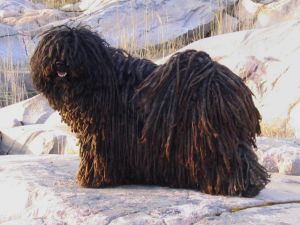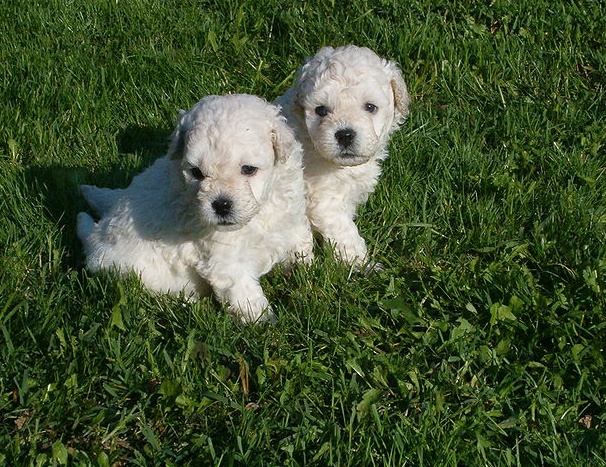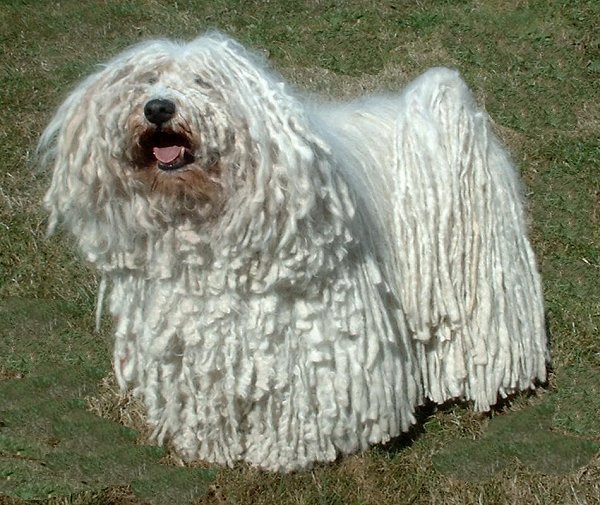The Puli Dog
The Puli Dog, also known as the Hungarian Puli, has a history that is woven among the sheepdogs of western Europe and has been a helper/drover assistant to Hungarian shepherds for over a thousand years.
 Courtesy: tremeo.exofire.net
Courtesy: tremeo.exofire.netAs a result of interbreeding with the Pumi and other sheepdog breeds during the 17th century, the breed so declined in number that it was in danger of being lost. Fortunately it was subsequently restored by dedicated breeders.
Pulik (plural) are sturdy, medium sized dogs, squarely built and muscular with a resemblance to the Tibetan Terrier - a distant relative of the breed.
The long corded coat is its most distinctive trademark, but is a feature
that is not seen right away in the adorable puppies until the coat
becomes more mature.
Characteristics of the Puli Dog Breed
This breed is an excellent family companion and is reputed to be highly intelligent and easy to train. Like most
herding dogs, they know how to think for themselves, which can come across as being a tad stubborn.
That being said, a confident
owner/leader with some experience in positive dog training will easily be able to train this smart dog around the
house as well as for competitive sports such as agility and obedience.
These are activities in which the breed excels and are also excellent ways to channel their high energy and athletic abilities. In the home, the Puli dog is a lively, cheerful and affectionate dog that loves play and getting attention.
He is naturally protective of his family,
though not aggressive. As with most herding dogs, early socialization is recommended to expose him to a variety of
people, places and situations.
 Puli Puppies courtesy Somogyi András
Puli Puppies courtesy Somogyi AndrásPhysical Stats And Care
Height: 16-17 inches or more
Weight: 22-30 pounds
Coat colors: Colors are predominately
solid and are seen in black, rusty black, gray, white, or a cream color, "fako" in Hungary. There is one variation
of the cream colored coat in which the dogs have a black mask. Black is the color most often associated with
the Puli dog breed.
There is no mistaking the unique coat of this breed, nor the obvious need for regular maintenance. The outer coat in long and full, while the undercoat is soft, woolly, and very dense. The cording of the coat naturally occurs while the dog is still in the puppy stage - around six months.
At this time the undercoat begins to mingle with the top coat. Although the coat in its normal corded state looks very unruly, it actually provides protection against the elements and/or potential injury when the dog is used for working.
Grooming of the coat can be done in two ways - either brushing to prevent the cords from forming, or routinely separating the cords into thin strands to prevent the cords becoming a magnet for dirt and parasites.
Owners report that the Puli seems to enjoy the grooming process, and with regular attention it doesn't become a daunting task. Bathing is also part of routine care, but the truth of the matter is that the coat does take a long time to dry.
On the plus side, this breed doesn't shed so you won't have to deal with a battle of hair around the house.
Plus, if the dog is not going to be a participant in dog shows, the cords can be clipped to a shorter length for easier care.
 Ch Banhegyi Ancsa with Mornebrake courtesy Sannse
Ch Banhegyi Ancsa with Mornebrake courtesy SannseHealth Notes
Th Puli dog usually enjoys a very healthy lifespan of up to fifteen
years. However, if you are intending to acquire a pure bred Puli puppy,
do ask the breeders you meet if their dogs are tested and have received
CHIC certification for the conditions most likely to affect the breed.
Responsible breeders will have their breeding stock tested for
hereditary conditions that are sometimes seen in this breed.
These include:
- hip dysplasia,
- eye problems such as progressive retinal atrophy, and
- deafness.
How Active is the Puli?
A very agile dog breed with a ton of energy. Owners should plan on
regular walks or jogs without fail after the Puli has attained his full
bone growth. Prior to that time, care should be taken not to over
exercise a puppy.
When fully grown, lack of sufficient exercise will result in a bored Puli dog and entice him toward mischievous behavior.

Dog Fitness Treadmill
A Great Way To Burn Off Excess Energy
Ideal Living Space
This breed is not fussy about accommodations, but since they are very energetic and so enjoy lots of play and romping, a yard is very desirable.
A rural setting would probably be the most ideal setting, providing it has secure boundaries to contain the inquisitive nature of the Puli.
A yard also provides a good place for training sessions as well as play and other necessary activities.
The Puli Dog With Children?
Pulik do best with older children who are considerate and gentle with
pets. Smaller children may be a bit overwhelmed by their level of energy
and herding instincts. However, the Puli dog is very gentle and affectionate, and are also very protective of children.
No matter what age a child may be, the best policy is to always have an adult closely supervise activities between pets and children.
Senior or Less Active Families?
The Puli dog breed is best suited to an active household and an experienced owner. Plus he has above average grooming and exercise needs.
That being said, they have been used successfully as therapy dogs and are known to be affectionate and gentle as family companions.
Share Your Puli Dog Pictures
Calling all Puli dog owners. Please share your Puli pictures and your story of how you came to choose this
wonderful unique breed for your companion.
Our visitors always enjoy hearing first hand accounts especially when they're about rare and ancient
breeds such as this one. So we've made it quick and easy to tell your story here.
Further Reading

Hungarian Puli Rare Breed
A special edition book and valuable resource for Puli owners and fanciers of the breed. Information includes breed history and characteristics, advice on puppy selection, raising and caring for the breed, health care, grooming, and training. Illustrated with over 135 color photographs.

Puli Guide
A comprehensive owner guide covering the history and characteristics of the Puli as well as the breed standard. Also included is advice an owner needs to know about selecting and caring for a puppy, feeding, grooming, obedience training, health care and maintenance.
For those interested in acquiring a Puli, find a list of breeders here/
- Home ›
- AKC Breeds ›
- Herding Breeds ›
- Puli
Photo Credits: Puli Puppies: Somogyi András, CC BY 3.0
Puli "Ch Banhegyi Ancsa with Mornebrake" by Sannse at the English-language Wikipedia, CC BY-SA 3.0
